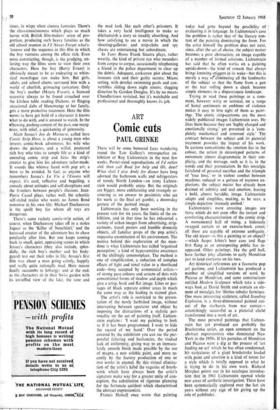Comic Cuts
ART
PAUL GRINKE
There will be some bemused faces wandering round the Tate Gallery's retrospective ex- hibition of Roy Lichtenstein in the next few weeks. Poster-sized reproductions of I'd rather sink than call Brad for help and Oh, dear! What shall I give Andy for dinner have long adorned the bathroom walls and refrigerators of trendy North London—an irony Lichten- stein would probably enjoy. But the originals are bigger, more exhilarating and strangely re- assuring as an answer to pessimists who see his work as the final art gambit, a doomsday gesture of the painted image.
Lichtenstein has only been working in the present vein for six years, the limits of the ex- hibition, and in that time he has exhausted a variety of urban images from advertising, strip- cartoons, travel posters and humble domestic objects, all familiar props of the pop artist's impassive examination of his environment. The motive behind this exploration of the mun- dane is what Lichtenstein has called 'organised perception,' a kind of hypersensitive awareness of the chillingly commonplace. The method is one of simplification, a reduction of complex effects of light and tonal value to a shorthand code—long accepted by commercial artists— of strong pure colours and screens of dots with conventional forms of shadow and depth which give a crisp, hard and flat image. Lines or pas- sages of black separate colour areas in much the same way as the leading in stained glass.
The artist's role is restricted to the presen- tation of the newly furbished image, without intervening between spectator and object by imposing the distractions of a stylistic per- sonality on the act of painting itself. Lichten- stein explains : 'I want my painting to look as if it has been programmed. I want to hide the record of my hand.' Over the period covered by the exhibition you can see the pur- poseful faltering and hesitancies, the studied lack of uniformity, giving way to an immacu- lately smooth finish made possible by the use of magna, a new soluble paint, and more re- cently by the factory production of one or two works in enamel. By this virtual elimina- tion of the artist's Mild the vagaries of brush- work which have always been the artist's signature make way for a greater unity of con- ception, the substitution of rigorous planning for the fortunate accident which Characterised the abstract expressionists.
Francis Haskell once wrote that painting today had gone beyond the possibility of evaluating it in language. In Lichtenstein's case the problem is rather that of the literary con- tent of the painting dominating the form. For the artist himself the problem does not exist, since, after the act of choice, the subject matter becomes a pure abstraction, an image capable of a number of formal solutions. Lichtenstein has said that he often works on a painting upside-down—the kind of remark -that always brings knowing sniggers in its wake—but this is merely a way oreliminating -all the landmarks of the subject so that the -flame from a gun -j or the tear rolling down a cheek become simple elements in a dispassiouate landscape.
Trying to read these paintings as a com- ment, however witty or satirical, on a range of banal sentiments or emblems of violence makes it easy to lose sight of them as paint- ings. The comic strip-cartoons are the most widely publicised images Lichtenstein uses. He likes them because they are 'highly charged and emotionally strong,' yet presented in a 'com- pletely mechanical and removed style.' The contrast between the subject and its pictorial treatment provides the impact of his work. In cartoon conventions the emotion lies in the colour, the action in stereotyped patterns of movement almost diagrammatic in their sim- plicity, and the message, such as it is, in the - words and their presentation. In this nostalgic fairyland of personal sacrifice and the triumph of 'true love,' or in- violent combat between machines reduced to a pattern -of toytown ex- plosions, the subject matter has already been drained of subtlety and real emotion, leaving a bold, almost heraldic, image. Lichtenstein adapts and simplifies, making, as he says, a simple depiction 'intensely unified.'
Lichtenstein's most arresting images are those which do not even offer the instant and comforting characterisation of the comic strip. A monumental ball of string, a hideously swagged curtain or an exercise-book cover; all these are capable of extreme ambiguity. The old teaser—is this a painting or an object? —which Jasper Johns's beer cans knd flags first flung at an unsuspecting public has re- appeared. Other paintings, like the golf ball, have further joky allusions to early Mondrian just to fceep everyone on his toes.
Art historical references are a favourite pop art pastime, and Lichtenstein has produced a number of simplified versions of work by Picasso or Mondrian, and some constructions entitled Modern Sculpture which take a side- ways loolcat David Smith and contain an ele- ment of nostalgia for 'thirties tubular furniture. One more interesting sculpture, called Standing Explosion, is a three-dimensional painted cut- out of the starbursts from war comics— astonishingly successful as a pictorial 'cliché transformed into a work of art.
The most personal paintings that Lichten- stein has yet produced are probably the Brushstroke series, an open comment on the abstract expressionists who dominated- New York in the 1950s. If his pastiches of Mondrian and Picasso were a dig at the process of 'art feeding on art' which he has often condemned, his caricatures of a giant brushstroke loaded with paint and emotion is a kind of totem for a style which is totally opposed to what he is trying to do in his own work. Richard Morphet point's out in his catalogue introduc- tion that in 1961 Lichtenstein opened whole new areas of aesthetic investigation. These have been systematically explored over the last six years without any sign of his giving up the role of pathfinder.






























 Previous page
Previous page